Effectiveness of treatmentbackachedirectly depends on how accurately it is conveyeddiagnosis. . . However, the pain syndrome itself is not some characteristic symptom - it is a general symptom, for which it is impossible to determine the cause of the disease. There are many different pathologies that can causebackache, and not all of them are associated with diseases of the musculoskeletal system.
When self -medicated, patients mistakenly believe that the most important thing is to cope with the pain, and they lose the view that every pain has a cause. Taking painkillers is a symptomatic treatment that does not affect either the outcome of the disease or the cause of the pain.
The main cause of back pain
Consider the main onesdiseasecausebackache. . . For ease of diagnosis, doctors divide the back into upper (cervical spine), middle (thoracic spine), and lower (lumbosacral).
Upper lower back pain
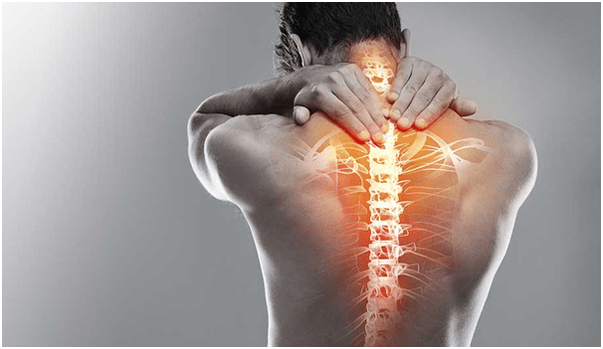
Pain in the cervical spine requires full attention. The reason is in the unique anatomical features of the cervical vertebrae: the vertebral arteries pass through them, supplying blood to the ⅓ brain; the first and second cervical vertebrae form complex articulations moving with the skull, which are responsible for turning and tilting the head; any disease that occurs at this stage has the potential to cause serious nerve damage, as damage or slight compression of the spinal cord in the cervical spine immediately leads to impaired motor and/or sensory function throughout the body.
Osteochondrosis of the cervical spine
Typically, intervertebral discs, joints, ligaments and tendons do not have blood vessels of their own; their blood supply depends on how intensively the nearby muscles and bones are supplied with blood. If this process is disrupted, for example, in office workers who lead sedentary and inactive lifestyles, degenerative-dystrophic changes begin in them. Nutrition of intervertebral disc cartilage and joints is affected, ligaments and tendons thicken, as a result of sclerotic changes the spinal canal narrows and the distance between vertebrae is reduced.
Among non -specialists, the disease is known as spinal osteochondrosis. Despite the fact that degenerative-dystrophic processes are characteristic of the entire spine, it is osteochondrosis that is the most common cause of pain in the cervical spine. Also, as in other parts of the spine, the disease can be complicated by an intervertebral hernia. However, due to the anatomical peculiarities of the cervical spine, even a small hernia can cause serious complications.
Trauma
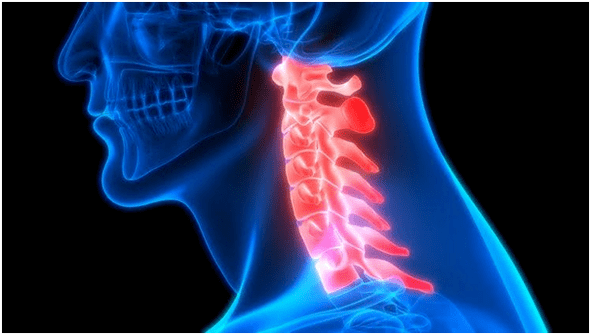
Although spinal cord injuries are more frequently diagnosed in the lumbar spine, nearly 50% of cases of spinal cord injuries occur with trauma to the cervical spine. This is due to the uniqueness of the neck anatomy: the absence of a well -developed muscular skeleton and large vertebral body, high mobility contributes to trauma even without direct physical effects (e. g. , by sudden stops or blows from behind during an accident, so -called neck whiplash injuries often occur, due toby a sharp flexion followed by a sharp extension of the cervical spine). Pain is the constant companion of any spinal cord injury.
Myositis
Myositis or inflammatory muscle disease is a whole group of diseases characterized by muscle pain. The most common cause of superficial muscle inflammation is forced posture when doing any work, hypothermia, drafts. Muscle pain can be the result of osteochondrosis of the cervical spine, intervertebral hernia - the muscles take most of the load on the neck, which eventually leads to overstrain, muscle spasm with impaired microcirculation and inflammation.
Neuralgia
Neuralgia is a condition in which the nerve fibers themselves become a source of constant pain impulses. The pain is paroxysmal, can be intensified and provoked by turning or tilting the head, cold weather. The cause of neuralgia is associated with diseases of the spine - osteochondrosis, intervertebral hernia, scoliosis, etc. The immediate cause of pain is irritation of the spinal cord roots when they are pinched in the intervertebral space, muscle spasm, which disrupts metabolism in the nerves that pass through the spasmodic muscles. Unlike neuritis or nerve inflammation, with neuralgia, the pain is periodic, there are no pathological changes in the nerve fibers themselves.
Heart disease
Heart diseases such as angina pectoris, ischemic heart disease, coronary artery atherosclerosis are often accompanied by pain that spreads to the neck, lower jaw, shoulders and left arm. The pain may be accompanied by numbness, tingling of the skin, resembling pain in osteochondrosis of the cervical spine with intervertebral hernia. Often, patients receive massage, physiotherapy, visit other doctors, even if the electrocardiogram is enough to diagnose the cause.
A characteristic feature of such pain is the ability of antianginal drugs that increase blood flow through the coronary arteries (isoket, nitroglycerin) to relieve pain within minutes.
Pain in the middle of the back
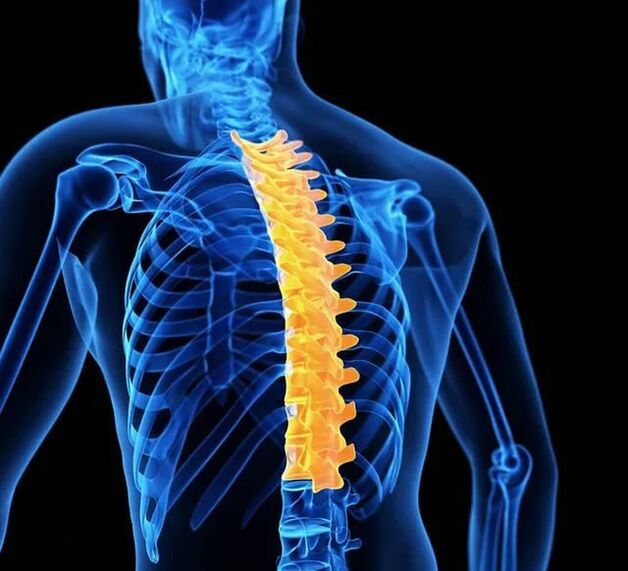
The thoracic spine is made up of 12 thoracic vertebrae, each of which has a pair of attached ribs. Together they provide protection for the chest organs. The size of the thoracic vertebrae gradually increases, starting from 1 thoracic vertebra and further to the beginning of the lumbar spine-this is explained by a gradual increase in the load on them. The mobility of the middle part of the back is much lower than the mobility of the neck, the ribs provide additional protection, which is why traumatic damage to the spinal cord in the thoracic spine is less common.
Curvature of the spine or scoliosis
Scoliosis or scoliotic disease is a pathological curvature of the spine in several planes. The cause of scoliosis is still not known exactly, the disease begins in childhood. Lack of physical activity, weakness of the back muscles, incorrect posture and organization of the workplace of school students are considered to be contributing factors. Due to the significant curvature, impaired load distribution and the biomechanics of the spine, the excess energy of the muscles that balances part of the load,arisechronicbackache.
Arthritis (spondyloarthritis)
The intervertebral joints, along with the intervertebral discs, unite the spine into one whole. Each vertebra has 4 articular surfaces that form an articulation with adjacent vertebrae. Like any other joint, the intervertebral joint can become inflamed. This pathological condition is called spondyloarthritis. There are two main causes of intervertebral joint inflammation. These are systemic rheumatic diseases (such as rheumatoid arthritis or ankylosing spondylitis) or reactive inflammation that occur in response to increased load in osteochondrosis, scoliosis and other pathologies of the spine. Inflamed joints lose their function: stiffness of movement, stiffness of the spine, prolonged back pain.
Gastrointestinal tract disease and back pain
Diseases of the abdominal organs are often the cause of pain that is reflected in the back and spine. There is also a direct link between gastrointestinal tract pathology and diseases of the musculoskeletal system. Diseases such as chronic colitis or gastroenteritis are the background for spondyloarthritis or osteochondrosis of the spine.
Often, reflected back pain occurs with gastric ulcer and duodenal ulcer, with hiatal hernia, acute or chronic pancreatitis. This phenomenon arises from the peculiarity of the sympathetic and parasympathetic systems, the nerve fibers found in every organ of the abdominal cavity. Some of the pain impulses they feel return to the roots of the spinal cord, mimicking pain in the spine and back.
Kidney disease and back pain
The kidneys are paired organs located in the retroperitoneal space, which, as in the case of the abdominal organs, are closely connected by nerves to the roots of the spinal cord. With the presence of inflammation, stones or other pathology of the urinary tract, part of the pain impulse reaches the spinal cord, simulating spinal disease.Symptoms of back paincan occur with acute pyelonephritis, renal colic, renal abscess. The characteristic symptom is tension of the back muscles in the projection of the kidney, which occurs as a result of inflammation of the kidney or with abscesses of tissue around it.
Pain in the lumbosacral spine

The lumbosacral spine has the greatest stress. Up to 60-70% of the adult population of developed countries complain of back pain. This is a favorite localization of an intervertebral hernia. A patient is most often diagnosed with 2-3 hernias in the lumbosacral spine. Also, pain in the lower back and sacrum often occurs with gynecological and urological pathology.
Intervertebral hernia
Intervertebral hernias are the result of long -term spinal osteochondrosis. While in the cervical region, a relatively small load is placed on the intervertebral disc, in the lumbosacral region, each disc has a very large pressure. A healthy disc is capable of balancing any weight, due to a semi -liquid core, which acts as a hydraulic shock absorber. However, due to osteochondrosis, the fibrous and strong cartilage (annulus fibrosus) that runs along the edge of the intervertebral disc loses its elasticity and strength, and some parts of it can crack. With a sudden increase in load, for example, when lifting weights, the pressure inside the diseased disc increases, because its contents can actually "shoot" through the damaged cartilage, falling into the lumen of the spinal canal - this is how intervertebral hernias form.
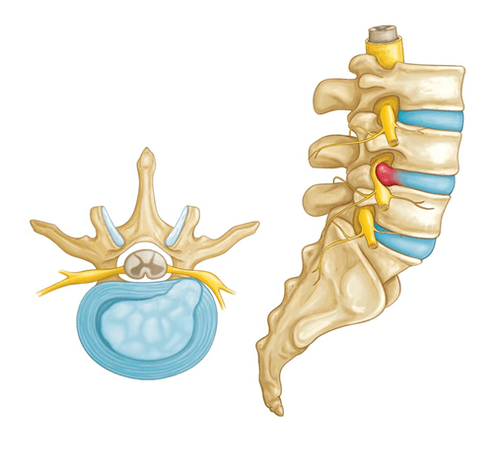
Fragments of the nucleus that have fallen out of the disc squeeze the spinal cord and spinal roots. As a result, there is swelling of nerve tissue and impaired blood circulation, which is accompanied by severe pain and spasm of the protective muscles. The pain can become unbearable, leading to the need for the use of narcotic analgesics. A characteristic feature is the radiation of pain in the lower part of the foot. There may be impaired sensitivity to pain, tingling and numbness of the skin of the lower legs and thighs.
Protrusion of the intervertebral disc
The main difference between intervertebral disc protrusion and hernia is the preservation of the integrity of the fibrous annulus. The cause of pain is compression of the spinal cord and its roots by protruding along the edges of the intervertebral disc. However, if the process continues, the bulge can easily turn into a hernia. The symptoms and pain are similar to a hernia disc, as the severity of the pain syndrome depends not only on the size, but also on the location of the protrusion or hernia.
Spondylosis of the spine
Excessive load and degenerative-dystrophic processes in the spine can cause hardening of cartilage tissue, which is saturated with calcium salts and turns into sharp coracoid bone growths or growths that arise along the edges of the vertebral body. With the development of the process, these results can be combined with similar growths on adjacent vertebral bodies. Over time, all the vertebrae grow together with each other, the spine loses its flexibility and elasticity. Pain occurs as a result of irritation of the spinal cord and its roots, reactive inflammation and dystrophy of the soft tissues, ligaments and muscles surrounding the spine.
Radiculitis
Radiculitis is called intense pain arising from circulatory disorders and ischemia of the spinal cord roots, choking by a hernia or protrusion with osteochondrosis of the spine. Various skin sensitivity disorders in the buttocks, perineum, thighs and lower legs are possible. Launched sciatica leads to atrophy and muscle weakness. The characteristic symptom is pain along the sciatic nerve, aggravated by movement, lifting weights and in cold weather. This condition is called sciatica or sciatica.
Spinal cord infections
The spine is made up of sponge bone tissue rich in bone marrow. When the infection enters the bloodstream in the vertebral body, an inflammatory process can occur - osteomyelitis. The gradual decay of bone tissue is accompanied by necrosis - this picture is also typical for spinal tuberculosis. Pain can occur both due to irritation of the nerve endings, and due to pathological compression fractures of the spine, weakened by inflammation.
Gynecological and urological diseases
Pathologies such as cervical cancer, endometriosis or adnexitis (complementary inflammation of the uterus) in women, prostatitis or prostate cancer in men are often accompanied by severe pain in the lumbosacral spine. The nature of the pain is explained by irritation of nerves trapped in areas of inflammation, or by the growth of nerve trunks by tumors.
Painful back muscles along the spine
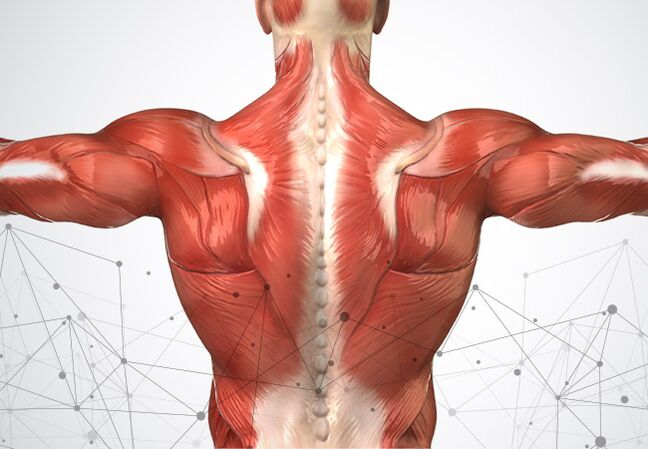
A well -developed back muscle is a sign of a healthy spine, as a muscular corset relieves some of the stress and also stabilizes the spine. In chronic diseases of the spine, the muscles are subjected to excessive load, which is unbearable by weak muscles and atrophy. As a result, muscle spasms occur, and are caused by metabolic disorders in the muscles and pain. This condition is called myofascial syndrome, which is characteristic of spinal osteochondrosis, hernia and protrusion of the intervertebral disc.
Pain after surgery
Spinal surgery is usually accompanied by extensive trauma - to stabilize and restore vertebral integrity, doctors can resort to installing metal structures, screwing screws into the vertebrae and removing non -viable tissue. The pain in this case is not only caused by the disease itself, but also by surgery. With proper recovery and postoperative care, the pain will gradually disappear. However, if in the postoperative period you ignore the doctor's instructions and ignore the mandatory exercises, the pain can become chronic.
How is the cause of back pain diagnosed?
To diagnose pain in the back and spine, it is necessary to seek medical help from a qualified neurologist in time. In the first stage, neurological examination, patient survey, reflex and symptom studies are performed. Experienced and competent physicians know very well what diseases back and spine pain suffer from certain causes and characteristic features.
Back pain for no apparent reason should be avoided. This can be caused by pain reflected in other organs and systems, with tumors and spinal cord disease.
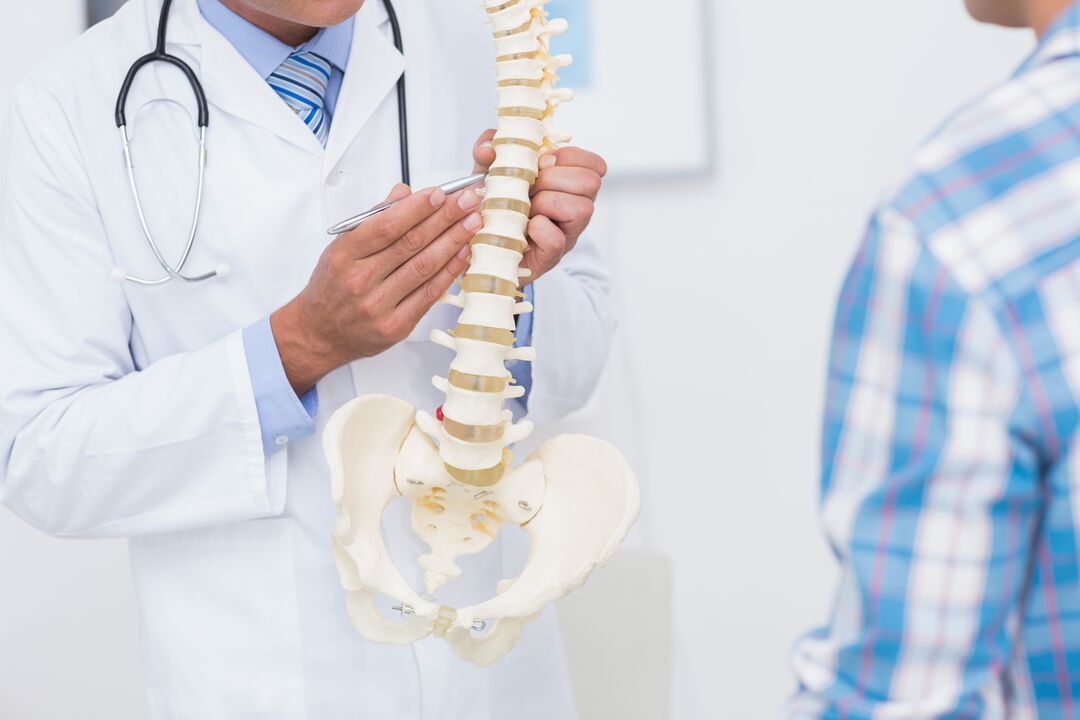
To find out the cause of back and spine pain, a neuropathologist may prescribe magnetic resonance imaging. It is the most effective and safest method for diagnosing almost all possible causes of back pain. The procedure is based on the ability of magnetic fields and radio waves to provide clear and detailed images of the spine and spinal cord without the use of X-rays and other harmful factors.
How to relieve back pain
To relieve, but not treat, back pain, let us take analgesics for a few days, which will have to wait for expert consultation. Often, non-steroidal anti-inflammatory drugs or NSAIDs are used for this purpose. However, it is important to remember that this group of drugs can cause dangerous side effects, the likelihood of which increases with prolonged use. That’s why it’s important not to postpone visits to the doctor and checkups for later. treatmentdiseasebackboneand reasonbackache.
Treatment of spinal pain
As noted earlier, the effectiveness of back pain treatment depends on the accuracy of the diagnosis made. While obvious, many patients "cure" pain for years, but not the disease itself, each time postponing a visit to the doctor, turning to traditional healers, osteopaths, and chiropractors. Moreover, for some diseases of the spine, such a procedure is not only contraindicated, but also dangerous.
There are effective and scientifically proven treatments for a varietyspeciesthe disease that causesbackache. . . Most of them require perseverance and perseverance of the patient in fighting the disease. It is important to remember that there are no pills or injections that can cure osteochondrosis - only you can do this, with hard training and physical training that a neurologist will show you.
Which doctor should I call for back pain?
Back pain is one of the most common neurological symptoms that occurs due to the involvement of nerves and spinal cord in pathological processes. Therefore, the first specialist, whose consultation is necessary to receive in case of pain in the spine, will be a neurologist. Based on the results of the examination and magnetic resonance imaging, you may need to see another doctor. If back pain is caused by heart disease, the patient is referred to a cardiologist, if problems in the digestive tract, to a gastroenterologist. But often pain syndrome is precisely associated with spinal pathology.

















































